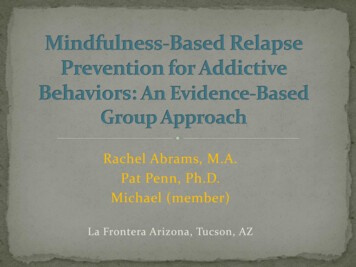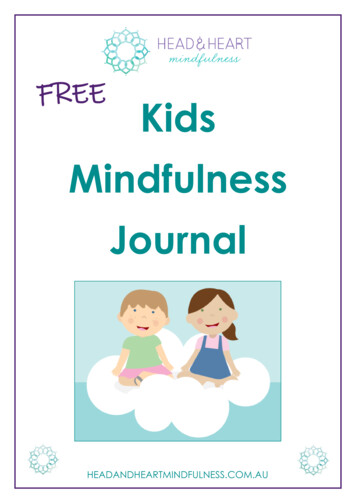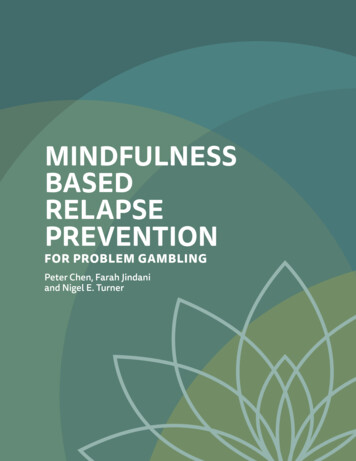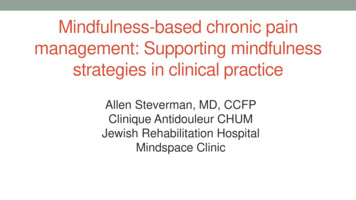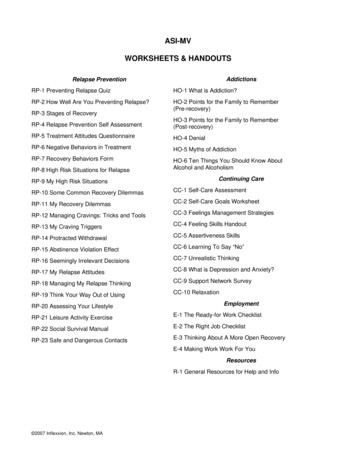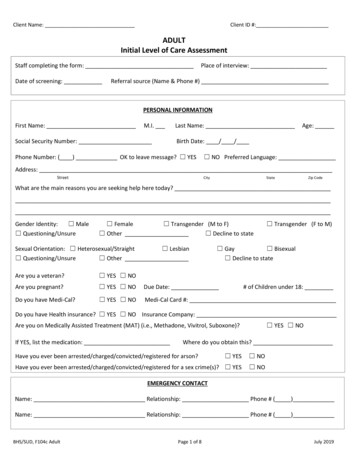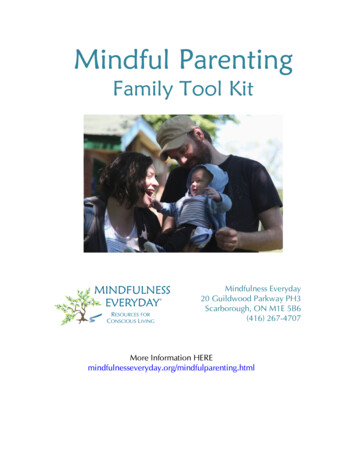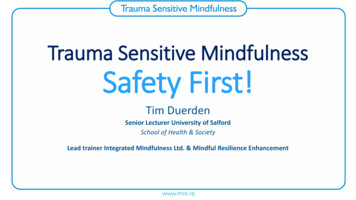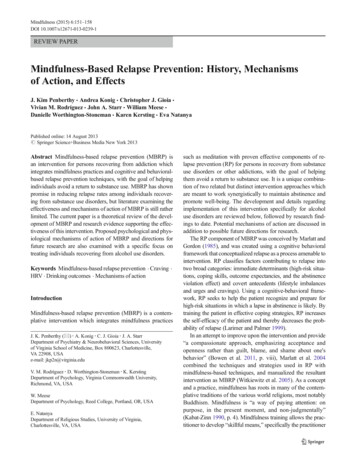
Transcription
Mindfulness (2015) 6:151–158DOI 10.1007/s12671-013-0239-1REVIEW PAPERMindfulness-Based Relapse Prevention: History, Mechanismsof Action, and EffectsJ. Kim Penberthy & Andrea Konig & Christopher J. Gioia &Vivian M. Rodríguez & John A. Starr & William Meese &Danielle Worthington-Stoneman & Karen Kersting & Eva NatanyaPublished online: 14 August 2013# Springer Science Business Media New York 2013Abstract Mindfulness-based relapse prevention (MBRP) isan intervention for persons recovering from addiction whichintegrates mindfulness practices and cognitive and behavioralbased relapse prevention techniques, with the goal of helpingindividuals avoid a return to substance use. MBRP has shownpromise in reducing relapse rates among individuals recovering from substance use disorders, but literature examining theeffectiveness and mechanisms of action of MBRP is still ratherlimited. The current paper is a theoretical review of the development of MBRP and research evidence supporting the effectiveness of this intervention. Proposed psychological and physiological mechanisms of action of MBRP and directions forfuture research are also examined with a specific focus ontreating individuals recovering from alcohol use disorders.Keywords Mindfulness-based relapse prevention . Craving .HRV . Drinking outcomes . Mechanisms of actionIntroductionMindfulness-based relapse prevention (MBRP) is a contemplative intervention which integrates mindfulness practicesJ. K. Penberthy (*) : A. Konig : C. J. Gioia : J. A. StarrDepartment of Psychiatry & Neurobehavioral Sciences, Universityof Virginia School of Medicine, Box 800623, Charlottesville,VA 22908, USAe-mail: jkp2n@virginia.eduV. M. Rodríguez : D. Worthington-Stoneman : K. KerstingDepartment of Psychology, Virginia Commonwealth University,Richmond, VA, USAW. MeeseDepartment of Psychology, Reed College, Portland, OR, USAE. NatanyaDepartment of Religious Studies, University of Virginia,Charlottesville, VA, USAsuch as meditation with proven effective components of relapse prevention (RP) for persons in recovery from substanceuse disorders or other addictions, with the goal of helpingthem avoid a return to substance use. It is a unique combination of two related but distinct intervention approaches whichare meant to work synergistically to maintain abstinence andpromote well-being. The development and details regardingimplementation of this intervention specifically for alcoholuse disorders are reviewed below, followed by research findings to date. Potential mechanisms of action are discussed inaddition to possible future directions for research.The RP component of MBRP was conceived by Marlatt andGordon (1985), and was created using a cognitive behavioralframework that conceptualized relapse as a process amenable tointervention. RP classifies factors contributing to relapse intotwo broad categories: immediate determinants (high-risk situations, coping skills, outcome expectancies, and the abstinenceviolation effect) and covert antecedents (lifestyle imbalancesand urges and cravings). Using a cognitive-behavioral framework, RP seeks to help the patient recognize and prepare forhigh-risk situations in which a lapse in abstinence is likely. Bytraining the patient in effective coping strategies, RP increasesthe self-efficacy of the patient and thereby decreases the probability of relapse (Larimer and Palmer 1999).In an attempt to improve upon the intervention and provide“a compassionate approach, emphasizing acceptance andopenness rather than guilt, blame, and shame about one'sbehavior” (Bowen et al. 2011, p. viii), Marlatt et al. 2004combined the techniques and strategies used in RP withmindfulness-based techniques, and manualized the resultantintervention as MBRP (Witkiewitz et al. 2005). As a conceptand a practice, mindfulness has roots in many of the contemplative traditions of the various world religions, most notablyBuddhism. Mindfulness is “a way of paying attention: onpurpose, in the present moment, and non-judgmentally”(Kabat-Zinn 1990, p. 4). Mindfulness training allows the practitioner to develop “skillful means,” specifically the practitioner
152learns to observe unpleasant sensations or emotions withoutjudgment (Witkiewitz et al. 2005) and without succumbing toautomatic reactionary behavior, such as substance abuse. In thecontext of MBRP, the key contribution of mindfulness practiceis “ to develop awareness and acceptance of thoughts, feelings and to utilize these mindfulness skills as an effectivecoping strategy in the face of high-risk situations” (Witkiewitzet al. 2005, p. 221). In combining mindfulness training techniques with the techniques of RP, Bowen et al. (2011) augmentthe power of the cognitive-behavioral approach of RP by usingmindfulness training to enhance the patient's ability to observehis/her emotional and physiologic state without reacting to itout of habitual patterns of behavior. By learning to observeexperiences consciously and without judgment, the patientbecomes able to use his/her awareness of his/her emotionaland physiological state of being to identify inner states thatmight trigger a relapse to addictive behaviors, and put intopractice coping strategies learned from RP. Mindfulness becomes a powerful supportive tool that allows the patient to gainenough objective “space” within their own emotional andphysiological experience, so that he/she may apply the copingstrategies learned and make a conscious choice not to perpetuate habitual patterns of behavior.An example of the utility of combining the two techniquesis seen through examination of abstinence violation effect.According to RP, one of the primary determinants of whethera lapse in abstinence will proceed to true relapse is the abstinence violation effect, which is a negative emotional responseto a lapse in abstinence that is common among recoveringaddicts. The abstinence violation effect occurs when theaddicted patient responds to a lapse with the thought that thelapse proves they are a failure and will never be capable ofpermanent abstinence, and it increases the likelihood that thepatient will proceed to relapse. In RP, the patient is encouragedto learn to see any lapse as an opportunity to “learn from one'smistakes” and develop skills and coping strategies to deal withsimilar situations in the future (Larimer and Palmer 1999).Mindfulness meditation techniques are particularly helpful incombating the abstinence violation effect by reinforcing asense of non-judgment and encouraging patients to take inexperiences simply as information about themselves and theirenvironment (Witkiewitz et al. 2005).According to Buddhist psychology, mindfulness trainingallows the practitioner to develop “skillful means,” specifically the practitioner learns to observe unpleasant sensations oremotions without judgment (Witkiewitz et al. 2005) and without succumbing to automatic reactionary behavior, such assubstance abuse. Through research studies and theoreticalcommentary, mindfulness-based interventions have receivedsignificant attention as an efficacious approach for the treatment of several psychological disorders including borderlinepersonality disorder (Linehan 1993), depression (Kabat-Zinn1990; Kabat-Zinn et al. 1992; Segal et al. 2002), stress (Kabat-Mindfulness (2015) 6:151–158Zinn 1990), and anxiety disorders (Evans et al. 2008). Withthe promising potential clinical applications of mindfulness,the translation of mindfulness-based practices to existing RPinterventions for the treatment of addiction has been proposed(Bowen et al. 2006; Hendershot et al. 2011; Marlatt et al.1980; Murphy et al. 1986; Witkiewitz et al. 2005). RP hasbeen shown to be an effective aftercare intervention inpreventing and/or reducing the frequency of relapse amongpatients who have received treatment for alcohol dependence(Larimer and Palmer 1999).Description of the InterventionMBRP incorporates therapeutic techniques consistent withcognitive-behavioral relapse prevention while maintaining aprimary focus on mindfulness mediation practices (Witkiewitzet al. 2013a). The MBRP protocol is carried out over a period of8 weeks, with weekly 2-h group sessions (Bowen et al. 2011).Each session follows a structured intervention plan that incorporates cognitive skills training such as identifying high-risksituations and coping skills training, approximately 30–45 minof meditation practices, and discussion of the experience(Bowen and Vieten 2012; Witkiewitz and Bowen 2010;Witkiewitz et al. 2013a). As compared to predominantlycognitive-behavioral interventions, the course of MBRP isintended to be a primarily experiential process with a limitedinclusion of psycho-education and theoretical instruction(Bowen and Vieten 2012). Please see Table 1 for a brief description of each session's therapeutic focus and group exercises.Research Evidence for MBRPCurrently, experimental literature examining the direct effectsof MBRP on relapse rates and alcohol consumption is sparse.Researchers have conducted pilot efficacy trials (Bowen et al.2009; Zgierska et al. 2008). The feasibility pilot studyconducted by Zgierska et al. (2008) analyzed the effect ofMBRP on alcohol relapse with no comparison group and arelatively small sample (N 19). Participants were allowed tocontinue other treatments concurrently, including motivationalenhancement therapy, RP, and 12-step facilitation. Significantlylower numbers of heavy drinking days (HDD) and total numberof drinks were found at post-treatment when compared tobaseline. However, only HDD remained significant at 4 weekspost-intervention, though the average number of drinksremained relatively lower than baseline rates. Percent daysabstinent did not significantly change at any time point. A totalof 15 participants completed the study; four dropped out of thestudy and were lost to follow-up. However, there were nosignificant differences at baseline on clinical or demographicvariables between those who completed versus those who
Mindfulness (2015) 6:151–158153Table 1 Therapeutic focus and exercise(s) unique to the eight sessions of mindfulness-based relapse preventionSessionFocusTherapeutic exercise(s)1234Automatic pilot and relapseAwareness of triggers and cravingMindfulness in daily lifeMindfulness in high-risk situationsRaisin exercise; body scan meditationWalking down the street; urge surfing; mountain meditationAwareness of hearing; breath meditation; SOBER breathing spaceAwareness of seeing; SM: sound, breath, sensation, thought; SOBER breathingspace in a challenging situation; walking meditation5678Acceptance and skillful actionSeeing thoughts as thoughtsSelf-care and lifestyle balanceSocial support and continuing practiceSM: sound, breath, sensation, thought, emotion; SOBER breathing space (in pairs)SM: thoughts; SOBER breathing spaceLoving-kindness meditationBody scan; concluding meditationSOBER stop, observe, breath, expand awareness, and respond; SM sitting meditationdropped out of the study. Because of the small sample size andlack of a comparison group, these results should be interpretedwith caution.Focusing on alcohol and other drug use, Bowen et al.(2009) conducted the first randomized controlled trial to examine the feasibility and efficacy of an 8-week MBRP intervention on substance use relapse. This study compared MBRP(n 93) to a treatment as usual (TAU) aftercare group (n 75)that was designed with a 12-step, process-oriented format.Forty-five percent of participants in the trial were alcoholdependent and intended to remain abstinent from alcohol.MBRP was shown to be a feasible intervention as evidencedby a high proportion of participants (86 %) engaging inmeditation practices following the intervention. Furthermore,over half of participants (54 %) continued these practices at4 months post-treatment. Results showed reduced substanceuse as well as decreased cravings for the MBRP group compared to the TAU group over time. Findings also revealed thatparticipants in the MBRP group showed increased acceptanceand a higher likelihood of acting with awareness by the end oftreatment than the TAU group. The authors note that attritiondid not significantly differ between the two groups at any timepoint. Thus, completion rates for the entire sample (N 168)were reported at post-intervention (61 %), 2-month follow-up(57 %), and 4-month follow-up (73 %).Witkiewitz and Bowen (2010) conducted secondary analyses on the Bowen et al. (2009) data to explore the relationsbetween depressive symptoms, cravings, and substance usebetween participants in the MBRP intervention versus theTAU group. Their results indicated attenuation of depressivesymptomatology and cravings following MBRP. In addition,craving scores significantly mediated the relation betweenpost-MRBP depressive symptoms and days of use at the 4month follow-up assessment. The authors suggested thatMBRP led to decreased cravings, which in turn weakenedthe need to alleviate psychological distress with substances.The authors further assert that these results are indicative ofthe ability of mindfulness training to allow the practitioner todecouple their habitual behavioral patterns from the emotionaland physiological experiences that historically trigger suchbehavior.Taken together, these studies demonstrate initial efficacyfor the clinical application of an 8-week MBRP program forthe prevention of relapse. However, due to the small samplesizes and the fact that control groups were TAU, these resultsare tentative. To the best of our knowledge, there are norandomized controlled studies examining the effect ofMBRP on RP in a group of alcohol-dependent individualsonly. Thus, more research is warranted to examine the efficacyof MBRP in preventing alcohol relapse.Proposed Psychological Mechanisms of ActionRelapse PreventionThe positive change evidenced in RP techniques has beentheorized to be influenced by several mechanisms of changeor “active ingredients” (Longabaugh et al. 2005; Morgensternand Longabaugh 2000). The core mechanisms of change thathave received the most attention and are proposed as theputative mechanisms of action in the RP model have beenself-efficacy (Kadden and Litt 2011), outcome expectancies,and coping skills (Morgenstern and Longabaugh 2000).However, as Hendershot et al. (2011) point out, few studiessupport these presumptions.Originally conceptualized by Albert Bandura (1977), efficacy expectancy is thought of as the belief that one cansuccessfully execute behaviors needed to produce a desiredoutcome, with an emphasis on specific behaviors rather thansimply the outcome. It is easy to imagine that one can achievea desired outcome, though success may not be possible without belief in those behaviors that are a prerequisite to theoutcome. Coping skills are the behaviors that individuals learn
154and successfully execute to produce a desired outcome.Specific coping skills developed in RP include identifyinghigh-risk situations in a hierarchical structure and promotingeffective response strategies. These response strategies caninclude environmental supports and behavioral, cognitive, oraffective coping strategies, and are developed during the therapy sessions and targeted homework assignments (Annis andDavis 1991).A study by Brown et al. (2002) exploring components of RPin substance-abusing individuals found that RP versus 12-stepfacilitation produced increased self-efficacy which accountedfor unique variance in the outcome of the study. Additionally,Witkiewitz et al. (2011a, b) found improvements in outcomesfor study participants who learned drink refusal skills, presumably increasing their feelings of self-efficacy, which in turnappears to be the primary mechanism of change in drinkingbehavior. Finally, in a study exploring the behavioral intervention arm of COMBINE (Witkiewitz et al. 2011a, b), thoseparticipants who received skills training regarding coping withcravings and urges demonstrated significantly improved drinking outcomes via decreases in negative mood and craving.Mindfulness MeditationPsychologists and researchers have suggested different waysof conceptualizing the mechanisms at work in mindfulnesstherapies, though these mechanisms have not been specifically analyzed in relation to alcohol dependence. Nevertheless,these proposed theoretical underpinnings are helpful in ourefforts to better conceptualize the mechanisms of action ofMM on alcohol dependence/alcohol relapse, and thus they arediscussed here briefly.Shapiro et al. (2006) have put forth three axioms of MM:intention, attention, and attitude. Of the three axioms, intention is the most relevant to alcohol dependence, and is referredto as one's purpose for engaging in MM (Shapiro 1992).Shapiro concluded that as experience with MM increases,intention shifts from self-regulation, to self-exploration, andfinally, to self-liberation. Shifts in perspective involve deidentification from the contents of consciousness and observation of moment-by-moment experience with increased clarity and objectivity; that is, shifts in perspective involve cultivating an intimate knowledge of the self that is facilitated bygreater emotional and behavioral distance from mental events.Such intentional shifts appear to be highly applicable toalcohol-dependent individuals, who must learn how to “detach” themselves from high-risk drinking situations in effortsto resist the urge to drink alcohol.Baer (2003) and Bowen et al. (2007) proposed similarmechanisms of mindfulness including exposure, cognitivechange, self-management, relaxation, and acceptance.Within this framework, nonjudgmental observation is viewedas an essential component that influences each mechanism.Mindfulness (2015) 6:151–158For example, with regard to exposure, nonjudgmental observation of anxiety-related thoughts and sensations may lead toreduced emotional reactivity when no attempt is made atescape or avoidance, or with regard to cognitive change,nonjudgmental observation may lead to an understanding thatanxious thoughts are “just thoughts,” and not static reflectionsof truth or reality (Baer 2003; Bowen et al. 2007). The latterexample is especially relevant to alcohol-dependent individuals, and the importance of teaching them how “thoughts”about wanting to drink alcohol (e.g., “I need to have a drink”)are just thoughts. With time and/or practice, thoughts aboutwanting to drink alcohol will subside in both frequency andintensity.Hölzel et al. (2011) proposed the most recent theoreticalframework of mechanisms that elicit change in mindfulnessbased therapies. This framework includes four steps—attention regulation, body awareness, emotion regulation, andchange in perspective on the self—that interact with eachother in chronological order. The authors theorize that whena stimulus triggers an emotional reaction, the executive systemattempts to regulate attention to the goal of remaining in amindful state. Body awareness detects physiological signs thatsignal the emotional response to the stimulus. Emotion regulation processes are engaged to prevent the occurrence of ahabitual, overlearned reaction, and with subsequent trials, thisfacilitated response prevention leads to extinction andreconsolidation of the self. The authors note that sustainedattention is crucial to this process, as any suppression oravoidance of the conditioned stimuli (e.g., anxiety, fear, orself-doubt) would prevent extinction of the conditioned response (e.g., alcohol consumption).In a recent review article, Brown et al. (2013) summarizemindfulness-based interventions in counseling and remarkthat Martin (1997) proposed that mindfulness may be a coreprocess that underlies multiple therapeutic approaches.Specifically, by providing clients with a means for exploringunpleasant thoughts, feelings, or behaviors, many of whichmay have previously been unnoticed or perceived as toooverwhelming for them, mindfulness can help counselorsfrom virtually any theoretical orientation facilitate changeprocesses in their clients (Martin 1997). Brown et al. (2013)summarizes that the internal state of attentional focus achievedvia mindfulness meditation can be considered a core processnecessary to facilitate change.Mindfulness meditation ultimately focuses on a goal not ofchanging thoughts or circumstances of the patient, but rather agoal to change the patient's relationship to these psychologicalphenomenon. Mindfulness training explicitly discouragesjudging thoughts, emotions, or sensations. Thus, some researchers (Teasdale 1999) have proposed that the changes inthe patient's relationship to his or her thoughts and beliefs maybe the core process responsible for therapeutic improvementwith mindfulness meditation.
Mindfulness (2015) 6:151–158To date, limited research has explored the core mechanismsof change of MBRP specifically. More recently, two studiesperformed secondary data analyses on the randomized controlled trial of Bowen et al. (2009) to examine (1) the role ofbetween-session practice and therapeutic alliance on changes inlevels of mindfulness following an MBRP program (Bowenand Kurz 2012), and (2) the potential mechanisms of action bywhich MBRP reduces cravings (Witkiewitz et al. 2013a, b).Bowen and Kurz (2012) discussed the positive role of thetherapist–client relationship on the client's level of mindfulness.They hypothesized that the stronger the therapeutic alliance, themore willing clients would be to mindfully explore their ownexperiences. In this study, therapeutic alliance was measuredusing the 12-item client version of the Working AllianceInventory, Short Form (WAI-S; Tracey and Kokotovic 1989).In addition, they predicted that the time spent (i.e., durationand frequency) between sessions actively engaged in mindfulness meditation practices would be related to higher levelsof mindfulness. Results revealed a significant positive correlation between time spent in mindfulness meditation betweensessions and increased levels of mindfulness at post-treatment,but these effects diminished at 2 and 4 months follow-up.Therapeutic working alliance was significantly associatedwith higher levels of mindfulness at post-treatment and2 months follow-up, but no effect was present at 4 monthsfollow-up. Their results support the importance of betweensession practice and therapeutic bond as significant predictorsof increased levels of mindfulness at post-treatment, yet further research is warranted to determine how to maintain thesegains at long-term (e.g., 6 months) follow-up intervals. In thesecond study (Witkiewitz et al. 2013a, b), the authors foundthat the processes of awareness, acceptance, and nonjudgment (assessed via self-report measures) mediated therelationship between receiving MBRP and levels of cravingat post-treatment. This finding adds support to the primaryobjective of MBRP—that is, to develop an ability to respondto internal and external stimuli by increasing awareness andacceptance, while maintaining a non-judgmental stance.Hsu et al. (2013) examined the moderating effect of affectregulation in MBRP reanalyzing data from the Bowen et al.(2009) study involving 168 participants with AOD use disorders patients. They found that the participant's level of distresstolerance was positively associated with mindfulness asassessed by mindfulness scales and that MBRP may be particularly helpful for those individuals entering treatment withlow distress tolerance skills.In conclusion, integrating mechanisms of change from RPand MM to form a comprehensive treatment model aids in ourcurrent theoretical understanding of how MBRP works. Thatis, coping skills used in traditional RP to prevent relapse aremodified to include periods of nonjudgmental, objective observation, and non-reactivity. Homework assignments, suchas 5-min (or longer, for those who have more experience with155MM) breathing exercises, are focused on practicing sustainedattention and emotion regulation when experiencing an urgeto drink. Thus, with continued practice in mindfulness andincorporating these techniques into one's arsenal of copingskills, an alcohol-dependent individual becomes more likelyto resist the urge to drink alcohol in identified high-risksituations and, with repeated success, becomes more confident(i.e., increased self-efficacy) in his or her ability to control hisor her drinking.Proposed Physiological Mechanisms of ActionAcute and chronic alcohol consumption is associated with thedysregulation of a number of physiological systems(Romanowicz et al. 2011; Thayer et al. 2006). Examiningthe physiological pathways which are disrupted as a result ofheavy drinking is essential because the central and autonomicnervous systems work together to regulate attention, cognition, and emotion when stressful cues are encountered, such aswhen an alcohol-dependent individual is exposed to stressfuland/or substance-related stimuli (Thayer and Lane 2000,2009). When individuals are not able to regulate their attentional, cognitive, and emotional responses, they are less ableto interact with the environment in an adaptable and efficientmanner (Thayer and Lane 2000). Thus, it is not surprising thatimpaired ability to self-regulate in response to stress is associated with the development of alcohol use disorders as wellas relapse (Quirk 2001).Heart rate variability (HRV) is generally seen as an index ofemotion regulation (Thayer and Lane 2000). HRV is defined asfluctuations in the length of inter-beat intervals (Romanowiczet al. 2011). By assessing the amount of time between heartbeats, or by focusing on certain frequencies of the heart ratewaves, we can better understand the roles of parasympatheticand sympathetic activity in self-regulation. Higher levels ofHRV are associated with greater emotional and behavioralflexibility and impulse control, as well as with better mentaland physical health outcomes (Allen et al. 2000; Berntson et al.1997). In contrast, lower levels of HRV are associated with awide range of medical and psychiatric disorders (Romanowiczet al. 2011) including acute and chronic alcohol ingestion(Ingjaldsson et al. 2003), anxiety, and depression (Friedman2007; Friedman and Thayer 1998; Musselman et al. 1998).It is known that mindful meditation affects central andautonomic nervous system functioning (Carlson et al. 2007;Davidson et al. 2003; Tang et al. 2009; Witek-Janusek et al.2008) and facilitates self-regulation. Among alcoholdependent in-patients, compared to those with low levels ofmindfulness, those with high levels of mindfulness were betterable to divert their attention from alcohol cues and had betterHRV recovery from stress/alcohol cues (Garland et al. 2012).It is known that trait levels of mindfulness are plastic and can
156be modifiable by training (Carmody et al. 2009). However,research has only begun to examine the potential of teachingmindfulness meditation to facilitate physiological regulationin response to stressors among substance users (Brewer et al.2009; Garland et al. 2011).In one study, 36 individuals with alcohol and/or cocaine usedisorders were randomly assigned to receive either 9 weeks of1-h mindfulness training (MT) or 12 weeks of 1-h cognitivebehavior therapy (CBT) in an outpatient setting (Brewer et al.2009). Drug use was assessed weekly, and mindfulness skillswere assessed before and after treatment. Within 2 weeks oftreatment completion, a personalized imagery stress task wascompleted during which physiological measures wererecorded. The results indicated that throughout treatment, therewere no group differences for participant retention or treatmentsatisfaction. As expected, both groups demonstrated increasedskin conductance and heart rate reactivity in response to personalized stress imagery. However, those in the MT groupshowed attenuated physiological responses to stress comparedto those who received CBT. These results suggest that mindfulness training has beneficial physiological effects amongindividuals with substance use disorders. However, it is important to recognize that due to the small sample size and the largedropout rate (only 14 completers), these findings may notgeneralize. Also, the study included a heterogeneous population with regard to substance use (individuals with alcohol and/or cocaine use disorders). These findings may not be applicableto individuals with only an alcohol use disorder.A more recent study examined the effect of mindfulnesstraining on physiological responding among alcoholdependent individuals (Garland et al. 2010). In this study, 53individuals with a lifetime history of alcohol dependence wererecruited from a long-term therapeutic treatment communityafter 18 months of sobriety because this represents a time ofincreased relapse risk. Participants were randomly assigned toattend either ten sessions of Mindfulness-Oriented RecoveryEnhancement (MORE) training or an Alcohol DependenceSupport Group (ASG). MORE is a ten-session, manualizedintervention which was adapted as a treatment for alcoholdependence from Mindfulness-Based Cognitive Therapy, amindfulness intervention designed to prevent depression relapse (Segal et al. 2002). Participants completed self-reportmeasures of psychological functioning and a stress reactivitytask before and after the 10-week intervention. In the stressreactivity task, participants were shown aversive and alcoholcue photographs (i.e., photographs of beer or wine) whileHRV was assessed. Individuals in the MORE group showedgreater reductions in self-reported perceived stress than ASGparticipants. Also, among MORE participants, self-reportedthought suppression decreased significantly from pre-to posttreatment. As expected, the groups showed differential physiological responding during the post-treatment stress reactivitytask. Relative to ASG participants, MORE participantsMindfulness (2015) 6:151–158showed higher HRV during alcohol cue exposure, whichdecreased as they practiced mindfulness meditation duringthe recover
Mindfulness-based relapse prevention (MBRP) is a contem-plative intervention which integrates mindfulness practices such as meditation with proven effective components of re-lapse prevention (RP) for persons in recovery from substance use disorders or other addictions, with the goal of helping them avoid a return to substance use.
